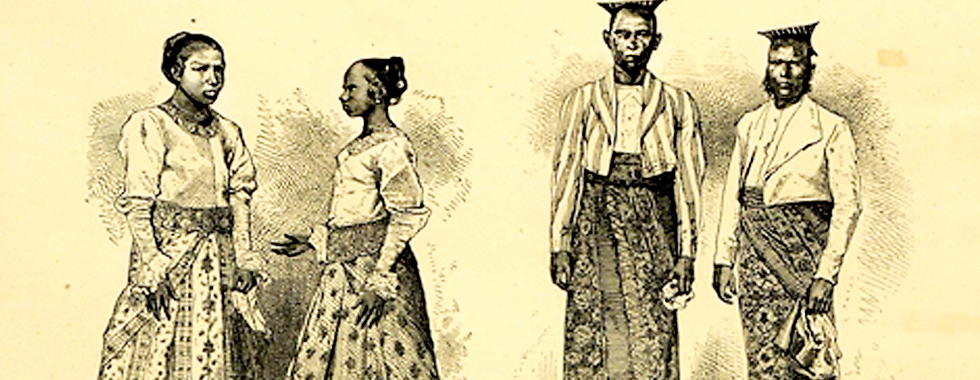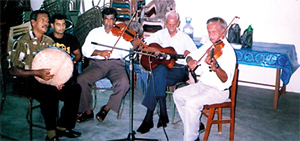When the Portuguese came to South Asia
Portuguese intervention in Indian Ocean trade and their missionary zeal were inevitably entangled. “Christians and Spices” were on the agenda from the outset. Being the first Europeans to engage in direct economic deals with Asians, the Portuguese were entering a zone that was largely unfamiliar to them culturally. Asian customs were moulded by ancient philosophies such as Buddhism and Hinduism alien to the Portuguese. Long-distance trade across continents, intersecting with a myriad of cultural systems, had its costs. But the trade off in dealing direct with Asian suppliers and cutting out the middlemen reaped handsome profits, turning Lisbon from a backwater to the spice market of Europe.

Portuguese influence seen in the dress code of early Ceylonese
A multitude of languages were spoken in South Asia. Language is not necessarily a barrier to trade but the evolution of contact languages (pidgins and creoles) whose lexifier language was Portuguese, undoubtedly enhanced communication between the Portuguese and ‘others’. In pidgin and creole Portuguese varieties, the majority of the words have Portuguese etyma.
Absence of women in the exploratory voyages to India which took about nine months, were inevitably a one-way journey for most Portuguese men. Unions between the Portuguese and South Asians resulted in mother-tongue speakers of creole Portuguese, which was called Indo-Portuguese by nineteenth century linguists. Following the pioneering work of Hugo Schuchardt (the German linguist and father of creole languages), Sebastião Rodolfo Dalgado (the Goan Priest and linguist), Adolfo Coelho, (the Portuguese philologist), Emilio Teza (the Italian philologist) and Leite de Vasconcelos (the Portuguese ethnographer and philologist), scholars began to study contact languages from the nineteenth century.
Creole Portuguese was assumed to be an inferior version of Portuguese and was called ‘broken Portuguese’ or ‘low Portuguese’. But linguists highlighted the importance of contact languages and the circumstances in which they evolved – to bridge the linguistic gap between peoples who came into prolonged contact and who needed a verbal means of communication. Contact languages are historically and sociologically significant, notwithstanding their importance to the field of linguistics. To linguists, contact languages are what Drosophila flies and guinea pigs are to biologists – pidgins and creoles allow linguists to test theories.
As translators and interpreters, people of mixed Portuguese and South Asian descent called mestiços (male) and mestiças (female) played a significant part in linguistic transmission even after official Portuguese presence ceased. Indo-Portuguese continued to be a lingua franca and was spoken by other Europeans who followed the Portuguese to the Indian Ocean and ousted them from their dominant position. In the sixteenth century, the Indian Ocean was a Portuguese lake. But from the mid-seventeenth century, rival European powers threatened Portuguese market shares and the Portuguese eastern empire became limited to a few enclaves in India, Macau and East Timor by the twentieth century. European Portuguese was spoken in parts of South Asia such as Goa where Portuguese domination continued for about four and a half centuries. Creole languages lack official support and understandably, they give way to the standard languages that are introduced. European Portuguese has therefore survived in Luso-Asian spaces which have withstood pressures from socio-political changes that followed decolonisation and where the ruling elite were Lusitanised such as Goa.
Portuguese words, facilitated by bilinguals through code-switching and code-mixing, were borrowed by Asian languages. Portuguese words in South Asian languages highlight areas of cross-cultural contact and cultural exchange: religion, education, furniture, architecture, music, dance, flora, fauna, temporal elements, transport, cuisine, clothing, names and administration (civil, military and legal). But lexical borrowing was not a one-way process. Asian words also entered Portuguese as the conquistadores encountered novel objects and concepts. But given the asymmetric power relations that surrounded the encounter, the number of words that the Portuguese borrowed from South Asia such as talagoya and rakshasa was far less than what the South Asians borrowed from Portuguese. However, Portuguese words were also borrowed by the European powers who followed them in Indian Oceanic trade. The Dutch and the British also spoke creolised Portuguese. In the mid-nineteenth century, English replaced Portuguese as the new lingua franca, the language of external trade and communication, and has remained so to the present day.

Portuguese Burgher musicians in Batticaloa
The existence of a large corpus of Indo-Portuguese sources, from the nineteenth and twentieth centuries, and the longevity of Indo-Portuguese provide data to make inferences about grammatical variation and language shift. Late nineteenth century manuscripts of Professor Hugo Schuchardt in the University of Graz (Austria) archives and the manuscript of Hugh Nevill, an English civil servant, in the British Library (London), enhance our knowledge on the linguistic and literary content of Indo-Portuguese. Creole songs have been handed down over the centuries through an oral tradition and the existence of Luso-Asian communities who still remember the lyrics enable scholars to make literary and linguistic comparisons.
The songs of the Portuguese Burghers in Batticaloa are a valuable source in studying not only language change but also the cross-fertilisation of musical traditions. Within Indo-Portuguese songs are embedded the vestiges of a language that is becoming moribund. Being an oral tradition and open to improvisation the lyrics of the songs have inevitably changed over the centuries. Portuguese ballads, still sung in Batticaloa, and kaffrinhas (Afro-Portuguese songs) have influenced contemporary popular music and song in Sri Lanka – baila. Hybridity and the resistance to cultural conformism are revealed through the new musical melanges that emerged. These cultural innovations illustrate that hybridity is played out in different ways in postcolonial societies, where new identities were carved out.
Music has been the most vibrant outcome of the encounter. Notions of European expansion generally focus on conquest and conflict. Cross-cultural flows can restore a sense of harmonious day-to-day encounters that took place between peoples. The extra-ordinary love of the Portuguese for music is well illustrated at the battle in El ksar el kabir (Morocco), in 1578 where 10,000 guitars were lying on the battlefield, near the dead bodies of the Portuguese soldiers. The Portuguese went to war with guns and guitars.
In cross-cultural encounters, the Portuguese affinity for music was a great asset. Music was a bridge and cultural flows were inevitable. Due to the different durations of the Portuguese presence in various parts of Asia, and the differences in the local music, the musical outcomes that resulted are also varied. But a common Iberian thread runs through them. Often this is mixed with African rhythmic patterns, syncopations and cross-rhythms which spark off the new musical forms. This cultural mixture is not surprising as the Portuguese empire was multi-ethnic with Africans and Asians serving in various capacities. An entirely new dimension was introduced by the Portuguese, to eastern music through harmony. Playing chords or several notes simultaneously was not known in the East. Together with musical forms and elements, new instruments, inevitably, were also introduced.
The intangible Lusitanian heritage has been stronger than the tangible, and is played out in language, literature, music and dance. Portuguese domination of South Asia was not uniform and linguistic and other cultural imprints reflect this. Sociopolitical and economic factors have also impinged on Luso-Asian communities and the tensions are manifested in the struggles for linguistic identity maintenance.
Surviving Portuguese cultural traits in South Asia illustrate that the colonial legacy is alive and not simply a relic in a museum. Histories have concentrated on major episodes, warfare and key personalities and royalty. What has been omitted in eyewitness accounts or traveller’s narratives remains hidden. In order to recover a part of the lost past, new methods must be employed. Studies of culture contact, processes of creolisation and cultural flows, provide a different lens to view the Portuguese encounters with South Asians.
comments powered by Disqus

